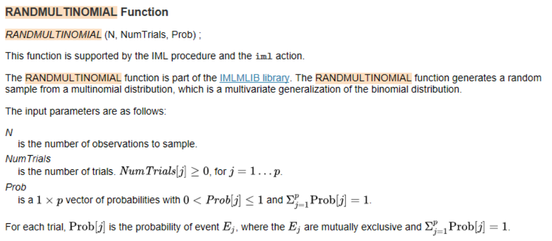- RSS Feed
- Mark Topic as New
- Mark Topic as Read
- Float this Topic for Current User
- Bookmark
- Subscribe
- Mute
- Printer Friendly Page
- Mark as New
- Bookmark
- Subscribe
- Mute
- RSS Feed
- Permalink
- Report Inappropriate Content
Hello,
I'm carrying out a simulation.
I was wondering why this works (I took it from https://blogs.sas.com/content/iml/2013/08/05/simulate-from-multinomial-distribution.html😞
proc iml;
call randseed(4321); /* set random number seed */
c = {"black", "brown", "white"};
prob = {0.5 0.2 0.3}; /* probabilities of pulling each color */
X = RandMultinomial(1000, 100, prob); /* 1000 draws of 100 socks with 3 colors */
print X[colname=c];while this does not:
PROC IML;
call randseed(4321);
c = {"1", "2", "3","4", "5", "6","7", "8", "9","10", "11", "12","13","14"};
prob = {0 0 0.125 0 0.125 0.25 0 0 0.125 0.125 0 0.125 0 0.125 };
X=RandMultinomial(100, 1000, prob);
print X[COLNAME=c];
QUIT;
The log says "ERROR: Matrix X has not been set to a value.".
I assume RandMultinomial can not simulate properly if one of the probabilities is 0. Nevertheless, I can't remove each 0 from the vector, that would be too time-consuming and inconsistent with my goal, I think.
Is there a way to carry out the simulation in SAS/IML keeping the 0's in the vector?
I know I could use the data step-approach reported here
https://blogs.sas.com/content/iml/2016/03/16/simulate-multinomial-sas-data-step.html
but I would like to keep it as simple as possible.
Thanks,
Simone
Accepted Solutions
- Mark as New
- Bookmark
- Subscribe
- Mute
- RSS Feed
- Permalink
- Report Inappropriate Content
You can write a short module that strips out the events that have zero probability. You can return Count=0 for the number of times that those categories occurred:
PROC IML;
/* Return count=0 for categories that have prob=0. */
start RandMult(N, NumTrials, prob);
ncols = prod(dimension(prob));
X = j(N, ncols, 0);
idx = loc(prob>0); /* only use categories for which prob > 0 */
posProb = prob[idx];
X[ ,idx] = RandMultinomial(N, NumTrials, posProb);
return X;
finish;
call randseed(4321);
c = "1":"14";
prob = {0 0 0.125 0 0.125 0.25 0 0 0.125 0.125 0 0.125 0 0.125 };
X=RandMult(20, 1000, prob);
print X[COLNAME=c];
QUIT;
- Mark as New
- Bookmark
- Subscribe
- Mute
- RSS Feed
- Permalink
- Report Inappropriate Content
Hello,
I can only say that the zero-probabilities are not allowed indeed.
From the doc:
Thanks,
Koen
- Mark as New
- Bookmark
- Subscribe
- Mute
- RSS Feed
- Permalink
- Report Inappropriate Content
You can write a short module that strips out the events that have zero probability. You can return Count=0 for the number of times that those categories occurred:
PROC IML;
/* Return count=0 for categories that have prob=0. */
start RandMult(N, NumTrials, prob);
ncols = prod(dimension(prob));
X = j(N, ncols, 0);
idx = loc(prob>0); /* only use categories for which prob > 0 */
posProb = prob[idx];
X[ ,idx] = RandMultinomial(N, NumTrials, posProb);
return X;
finish;
call randseed(4321);
c = "1":"14";
prob = {0 0 0.125 0 0.125 0.25 0 0 0.125 0.125 0 0.125 0 0.125 };
X=RandMult(20, 1000, prob);
print X[COLNAME=c];
QUIT;
- Mark as New
- Bookmark
- Subscribe
- Mute
- RSS Feed
- Permalink
- Report Inappropriate Content
Dear Rick,
I am so thankful for your reply, which definetely made my day.
Yours sincerely,
Simone
April 27 – 30 | Gaylord Texan | Grapevine, Texas
Registration is open
Walk in ready to learn. Walk out ready to deliver. This is the data and AI conference you can't afford to miss.
Register now and lock in 2025 pricing—just $495!
- SAS Webinar: Generierung synthetischer Daten | 04-Dec-2025
- Ask the Expert: Wie kann ich Visual Studio Code als SAS Entwicklungsumgebung nutzen? | 11-Dec-2025
- Ask the Expert: Marketing Decisions Excellence: Turning Insights Into Business Impact | 16-Dec-2025
- SAS Bowl LVII, SAS Data Maker and Synthetic Data | 17-Dec-2025
- SAS Innovate 2026 | Grapevine, Texas | 27-Apr-2026



